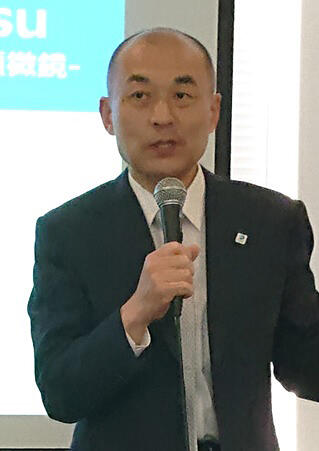"NanoTerasu," a soft X-ray synchrotron radiation facility that boasts world-class performance, has begun full-scale operations. Three public beamlines (BLs) are available for use by researchers: namely soft X-ray ultra-high resolution resonant inelastic scattering, soft X-ray nano photoemission spectroscopy, and soft X-ray nano absorption spectroscopy, which will be in public service from March 2025. In addition, seven Coalition BLs are available.
Masamitsu Takahashi, the Director of the QST NanoTerasu Center, said, "For the public BLs, the Japan Synchrotron Radiation Research Institute (JASRI), which has a proven track record at SPring-8, will be responsible for soliciting and selecting proposals and supporting users, while the Photon Science Innovation Center will be responsible for the use of coalition BLs. We will promote a high level of science and technology by advancing curiosity-driven issues of public service and problem-solving coalitional issues," he enthused.

Synchrotron radiation is produced in the tangential direction when electrons accelerated to near the speed of light are bent. This synchrotron radiation enables us to see the function and form of materials at the nanoscale level or lower, accelerating research and development in various fields such as biology, planetary and earth sciences, energy, materials, devices, and food. Therefore, approximately 50 synchrotron radiation facilities have been established throughout the world. Japan has been leading the world as a country of advanced synchrotron radiation. These facilities are, based on energy and wavelength, divided into two categories: (1) those that handle hard X-rays, which reveal the structure of matter at the atomic level, and (2) those that handle soft X-rays, which reveal the electronic state of matter.
"SPring-8," a large synchrotron radiation facility built in the 1990s, is one of the world's most advanced facilities. However, it handles only hard X-rays, and while overseas facilities for soft X-rays were completed one after another in the 2000s, Japan was left behind. Therefore, NanoTerasu, which has the world's highest performance in soft X-rays, was established through a public-private partnership, inheriting the technology developed at SPring-8 and the free electron laser facility "SACLA." It incorporates state-of-the-art technologies: a storage ring that confines electrons in orbits with small cross sections and the electrons move around the orbits, an undulator (insertion light source) that produces high-brilliance synchrotron radiation, a C-band accelerating tube, and a transparent grid thermal cathode electron source.
The soft X-ray ultra-high-resolution resonant inelastic scattering BL has the world's highest energy resolution, capable of detecting energy changes of 1/100,000, thanks to the longest beamline optics of NanoTerasu, and can shed light on various electronic state changes occurring in materials. For example, research on the electrode reactions of various batteries and the changes in electronic states associated with chemical reactions will advance research on battery longevity. Soft X-ray nano photoelectron spectroscopy BL realizes photoelectron spectroscopy measurements using bright nano-focused soft X-ray beams with the high brightness of NanoTerasu and high-efficiency X-ray mirrors produced in Japan. The electronic state of a material, including its spin, can be determined with nanoscale spatial resolution. For example, the observation of micro single crystals and electronic phase separation states will lead to the development of next-generation electronic device materials and high-temperature superconductors.
Soft X-ray nano absorption spectroscopy BL uses the world's first split undulator to create a wide variety of polarization states over a broad energy range and to switch between them quickly. The same sample can be used to see the difference in absorptivity between rightward and leftward polarization. For example, optically active materials can be analyzed using circularly polarized light, and novel magnetic structures such as skyrmions can be observed.
These three public BLs will be available for public use from next year. Of the approximately 6,000 hours of annual machine time, 3,000 hours will be for public service in the first year and eventually raised to 5,000 hours. Researchers affiliated with coalition member universities, research institutes, and private companies (approximately 150 institutions) can use seven coalition BLs, including soft X-ray electronic structure analysis, soft X-ray operando spectroscopy, soft X-ray imaging, and total X-ray structure and electronic structure analysis.
Takahashi stated, "By using multiple BLs, we can research and develop solutions to problems."
Large-scale research facilities for analyzing the structure and properties of materials include SPring-8 and J-PARC, which uses neutrons. QST President Shigeo Koyasu added, "In the future, we need to create a system that allows one-stop access to multiple large-scale research facilities."
This article has been translated by JST with permission from The Science News Ltd. (https://sci-news.co.jp/). Unauthorized reproduction of the article and photographs is prohibited.




